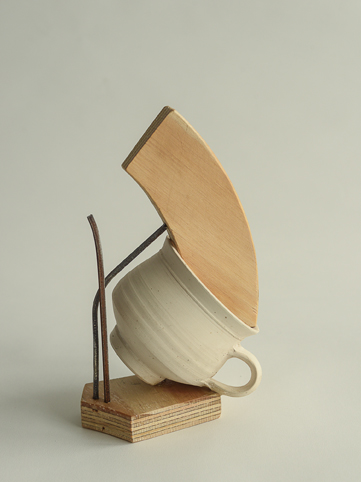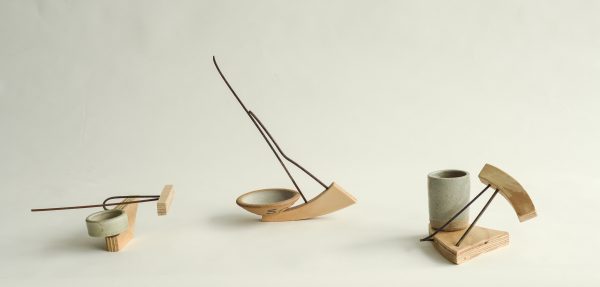

steel, birch ply, ceramic
Text for accompanying small publication:
I have always been interested in the relationship we have with physical objects. How we perceive desirability, function, and purpose, and the different monetary and cultural values that affect this. Yet, the pressure to define ourselves through the things we deem desirable is contributing to a social and environmental time bomb.
In February 2016 my partner’s father, potter Arthur Griffiths, died. There was a collection of small pots in his workshop, some of which had been fired but not glazed, some of which had been used to test glazes. After he died, they were put into a large bucket, which was brought to my studio, as no-one wanted to throw them away.
The presence of the bucket of pots under my studio table led me to make the series of nine small works ‘The Dilemma of the Non-ephemeral Artefact’.
Both Arthur’s and my work originate in the 20thcentury Modernist practice of exploring aesthetics of form, space and material, although we are influenced by very different intentions. Using Arthur’s experiments and unfinished pieces seemed a good starting point for me to experiment, both in terms of materials and exploring ways of communicating ideas.
Each sculpture is constructed using one pot and three or four birch plywood and steel elements. These elements come from offcuts from previous works, so also have a history. I have worked with steel for all my career. The plywood is a newer material for me to use. The steel defines 3D linear forms; drawing in space, while the plywood gives mass and allows simple junctions.
By incorporating the pots into sculpture, they are given an alternate life. The sculptures are almost mini-architectural models or maquettes for larger works, although there is no intention to make them on a grander scale. The scale of the pots in relation to the other materials makes them seem slightly surreal, the way seeing something you’re familiar with placed in a different context changes the meaning of the original object, sometimes in an unexpected way.
I am attempting to address how to deal with the emotional power objects can have over us, and to explore the value given by the artist, beyond utility and economics.
I am not sure what ‘place’ these sculptures have in the world, but I have made them anyway. This is all part of asking the loaded (and possibly universal) question: What are we going to do with all this stuff?